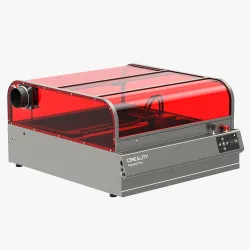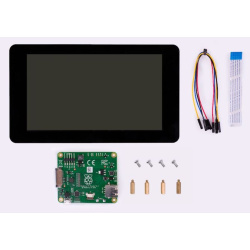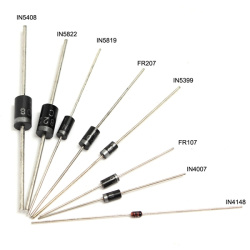Special Offers
In honour of Raspberry Pi's 10th birthday, we've fused a RP2040 microcontroller with an EPD display to produce a stylishly monochrome, maker friendly, e-paper badge(r) to attach to your person, your office door or to prop up on your desk.
We've equipped Badger 2040 with plenty of buttons so you can easily change what's displayed on the screen, a slot so you can clip it onto a lanyard and a battery connector so you can keep things portable and refresh the screen whilst on the go. On the back, you'll find some funky badgerpunk stylings plus our RP2040 accoutrements of choice: boot and reset buttons and a Qw/ST connector so it's super easy to plug in Qwiic or STEMMA QT breakouts
Here are some things you could do with it!
- Switch between images, pronouns or secret identities at the push of a button
- Make yourself into a mobile weather station or air quality monitor (by adding a sensor breakout)
- Store important QR codes for getting into places (or to Rickroll people)
- Make a tiny to-do list and tick stuff off
- Display inspirational badger quotes or educational badger facts of the day
Want to show your Badger the world? We've put together a convenient Badger + Accessory Kit which contains batteries, a lanyard and everything else that's needed to get portabello.
RP2040 x e Ink®
We're big fans of electronic paper at Pirate HQ - it makes for a lovely, crisp, high contrast display that's readable even in bright sunlight and it doesn't squirt unnecessary blue light into your environs like LCDs do. It's also ultra low power (EPD displays only consume power while they're refreshing), and the images on the display stick around for a really long time whilst the display is unpowered.
Using a RP2040 chip means we can drive the hardware in fun, experimental, low level ways. We've written custom drivers for the EPD display that prioritise low power consumption whilst enabling lightning fast refresh rates.
Features
- 2.9" black and white E Ink® display (296 x 128 pixels)
- Ultra wide viewing angles
- Ultra low power consumption
- Dot pitch - 0.227 x 0.226 mm
- Powered by RP2040 (Dual Arm Cortex M0+ running at up to 133Mhz with 264kB of SRAM)
- 2MB of QSPI flash supporting XiP
- Five front user buttons
- Reset and boot buttons (the boot button can also be used as a user button)
- White LED
- USB-C connector for power and programming
- JST-PH connector for attaching a battery (input range 2.7V - 6V)
- High-precision voltage reference for battery level monitoring
- Qw/ST (Qwiic/STEMMA QT) connector
- Fully-assembled (no soldering required)
- Schematic
- Mechanical drawing
- C++/MicroPython libraries
About RP2040
Raspberry Pi's RP2040 microcontroller is a dual core ARM Cortex M0+ running at up to 133Mhz. It bundles in 264kB of SRAM, 30 multifunction GPIO pins (including a four channel 12-bit ADC), a heap of standard peripherals (I2C, SPI, UART, PWM, clocks, etc), and USB support.
One very exciting feature of RP2040 is the programmable IOs which allow you to execute custom programs that can manipulate GPIO pins and transfer data between peripherals - they can offload tasks that require high data transfer rates or precise timing that traditionally would have required a lot of heavy lifting from the CPU.
What's in the box?
1 x Badger 2040
1 x (2 x AAA) battery holder
2 x AAA batteries
1 x Velcro square
1 x Black lanyard (made from recycled plastic bottles!)
1 x USB-C to USB-A cable
Resources
Software
Because it's a RP2040 board, Badger 2040 is firmware agnostic! You can program it with C/C++, MicroPython or CircuitPython. We'd recommend using our batteries included MicroPython build for ease of getting started.
You can draw on the screen using our lightweight PicoGraphics library, which includes functions for displaying text, shapes and images (plus individual pixels of course), and we've provided some examples to get you started.
Badger ships pre-loaded with MicroPython and our BadgerOS suite of examples.
MicroPython
- (Learn) Getting Started with Badger 2040 (and W)
- (Readme) Installation instructions
- Download Badger flavoured MicroPython (with Badger OS examples)
- Badger 2040 function reference
- PicoGraphics function reference
C/C++
You can also use CircuitPython on your Badger 2040. CircuitPython drivers are designed to work on a bunch of different microcontrollers so you won't get the fancy RP2040-architecture specific tweaks that you'll find in our library, but you will get access to all the nice conveniences of Adafruit's ecosystem.
- Download CircuitPython for Badger 2040
- Getting Started with CircuitPython
- CircuitPython examples
- BadgerOS ported to CircuitPython by Stephane BeBoX
Printables
Want to protect Badger from knocks and scrapes? Check out these nifty 3D printable cases and enclosures!
- Badger Guard (simple backplate with standoffs)
- Badger 2040 stand by samuelmcdermott
- Case for Pimoroni Badger 2040 by hsavior
- Badger 2040 enclosure by Andreas Känner
- Badger 2040 keypad by Andreas Känner
Notes
- Measurements: 85.6mm x 48.7mm x 10mm (L x W x H, including connectors). The mounting holes are M2 and 2.9mm in from each edge. The corner radius is 3mm.
- Badger 2040 is fairly accommodating about input voltage (2.7V - 6V), so it's possible to use a variety of different batteries and battery packs. A 2x AAA battery pack fits behind Badger nicely (double/triple AA and AAA battery packs will also work though).
- 2x AAA rechargeable (NiMH) batteries only puts out 2.4V which is, strictly speaking, not enough for Badger. However, in our tests it keeps on truckin' down to an input voltage of 2.05V (without the LED), so if you want to use rechargeable batteries that should be fine.
- Alternatively, you can plug a LiPo/LiIon battery into the battery connector, with the following caveats. Please only consider this if the person wearing the badge is an adult and knows what they're doing with LiPos!
- A solid enclosure or backplate to protect the battery from damage whilst being worn is a very good idea .
- There's no battery protection included on Badger 2040, so you should only use it with LiPo batteries that include internal protection.
- Unlike some of our other boards, Badger 2040 doesn't have battery charging circuitry onboard. You'll need an external LiPo charger to charge the battery.
- With older versions of the Badger firmware, reset behaviour is slightly different when running on battery. If you're running on battery power, you will need to tap the reset button on the back, and then hold any of the front buttons to wake it up and trigger a refresh. With version 1.18.5 or later of the Badger firmware you won't need to do this.
- Never set your password as "mushroom". It is not stroganoff.
This board is designed to dock with a BBC micro:bit using the micro:bit's edge connector. The board is a true CO2 sensor that also measures temperature and relative humidity.
Features
- Low power -- power directly from your micro:bit
- CO2 0-5000ppm, temperature and relative humidity measurement
- Has a makecode library to simplify programming
Please note that this product, while it has many of the same features as the MonkMakes CO2 for micro:bit is based on a completely different sensor and is not a direct replacement for use in the Living Space project (amendments will need to be made to the teacher's notes).
What's in the box?
1 x CO2 Dock for micro:bit (Micro:bit not included)
Resources
https://monkmakes.com/downloads/datasheet_co2_dock.pdf
https://monkmakes.com/downloads/instructions_co2_dock.pdf
This board is designed to interface to a BBC micro:bit through ring connectors. The board is a true CO2 sensor that also measures temperature and relative humidity.
Features
- Low power -- power directly from your micro:bit
- CO2 0-5000ppm, temperature and relative humidity measurement
- RGB LED indicates CO2 level
What's in the box?
1 x CO2 Mini Kit for micro:bit
This DIN rail bracket is a reliable mounting accessory designed to secure electronic components, circuit boards, and terminal blocks onto standard DIN rails commonly used in industrial automation, electrical enclosures, and control panels. It ensures stable and organized installation, preventing movement or disconnection due to vibrations or mechanical stress. Made from high-quality insulating plastic, it provides excellent durability and protection against environmental factors, ensuring long-term performance in industrial settings.
With its pre-drilled holes and included screws, this bracket allows for quick and hassle-free installation, reducing assembly time and maintenance efforts. It is compatible with various industrial components such as relays, power supplies, PLC modules, and circuit protection devices, making it an essential accessory for control systems and wiring applications. Whether used in electrical cabinets, automation systems, or industrial machinery, this DIN rail bracket enhances organization and efficiency in any setup.
Features
- Material: PA66V0
- Wiring Method: Track Wiring
- Colour Classification: DRG-01
- Compatible with M3x10mm screw
- Supports standard DIN rails dimensions (Width: 35mm Height:7.5mm)
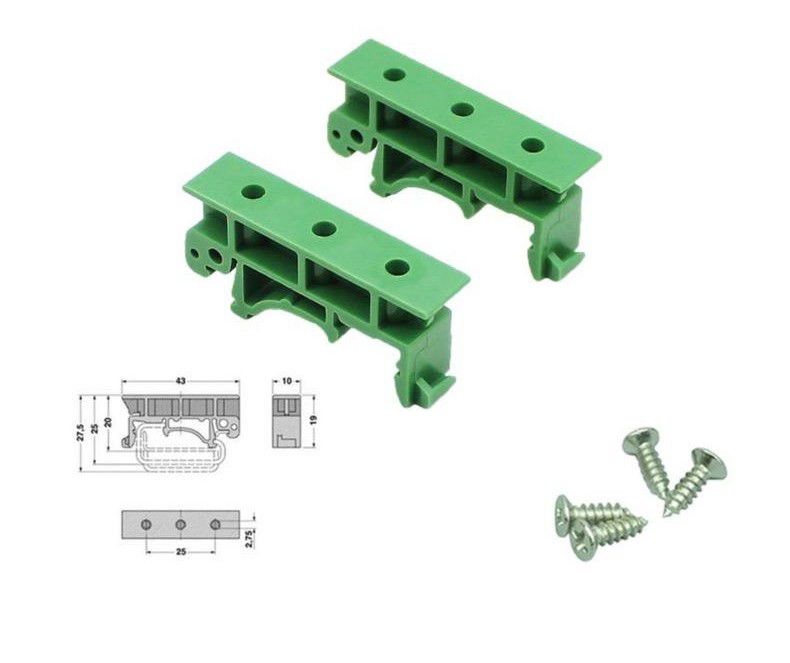
What's in the box?
2 x DIN Rail Bracket
4 x M3 Screw (10mm)
Interstate 75 W is a RP2350-based driver board for HUB75-style LED matrices - they're the chainable LED panels (32 x 32 or 32 x 64) that you sometimes see making up video walls or big advertising displays. It's designed to plug neatly into the back of a LED panel, and it provides a quick and easy way to whip up some scrolling signage or an eye-catching LED display for sensor outputs. I75 W has wireless connectivity so you can also use it to display information from the internet! ????
It's powered via USB-C, which should also be able to power a few connected panels happily, assuming you're not planning anything too eye-bleedingly bright. It has three handy user buttons (A, B and BOOT) and an onboard RGB LED.
We've also popped a Qw/ST connector on there, to make it super easy to plug in Qwiic or STEMMA QT breakouts.
Here are some things you could do!
???? Tap into an API and display bus times, plane tracking or traffic info.
???? Generate a big bold graph showing air quality or other sensor readings.
???? Create some ad hoc, easily adjustable signage for your classroom, maker stall or kebab shop.
???? Scroll greetz to your crew, just like in the old days:
"`-._,-'"`-._,-' HACKED AND PACKED BY PIMORONI "`-._,-'"`-._,-'
Features
- Powered by RP2350A (Dual Arm Cortex M33 running at up to 150MHz with 520KB of SRAM)
- 4MB of QSPI flash supporting XiP
- Raspberry Pi RM2 module (CYW43439), supporting IEEE 802.11 b/g/n wireless LAN, and Bluetooth
- Compatible with our 32x32, 32x64, 64x64 and 128x64 LED matrices.
- Sturdy screw terminals for powering the LED panels
- USB-C connector for programming and power
- Two user buttons (labelled A and B)
- Reset and boot buttons (the boot button can also be used as a user button)
- RGB LED
- Qw/ST (Qwiic/STEMMA QT) connector
- Comes fully-assembled (no soldering required)
- Programmable with C/C++ or MicroPython
What's in the box?
1 x Interstate 75 Matrix driver board
Resources
Pinout and Schematic
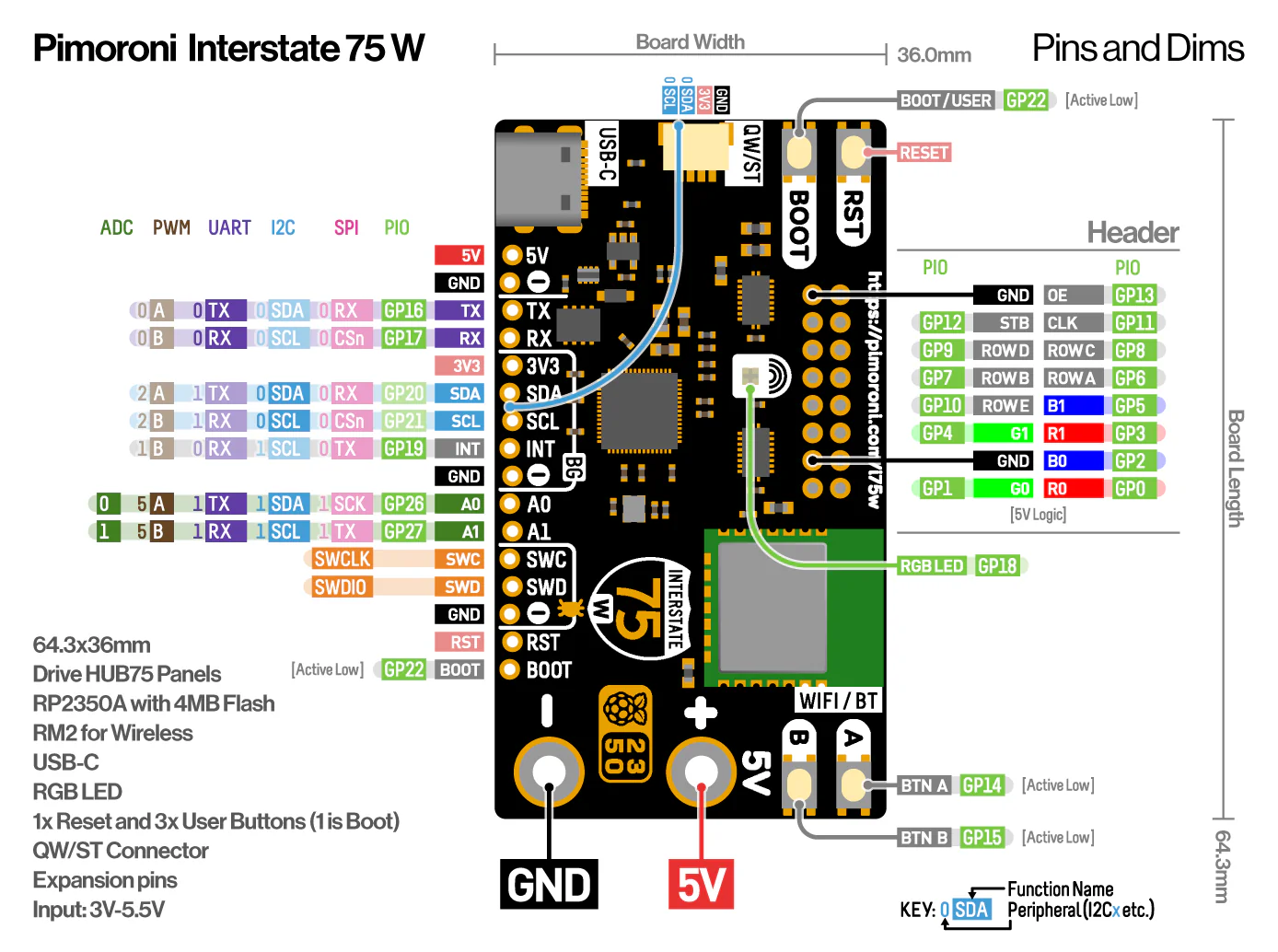
Getting Started
You can find the most recent version of the MicroPython firmware and examples at the link below:
Connecting Breakouts
I75 W has a Qw/ST (AKA Qwiic/STEMMA QT) connector, so you can connect up Qw/ST breakouts easily using a JST-SH to JST-SH cable.
We've also broken out a bunch of useful pins along the bottom edge of the board (including I2C, analog, UART and debug pins) so you can solder things like breakouts or analog potentiometers directly to them.
Notes
- Measurements: approx 64.3 x 36 x 17mm (L x W x H, including connectors)
About RP2350
The RP2350 chip is the Double Quarter Pounder & Fries to the RP2040's Double Cheeseburger and can have one or more RISC-V burgers instead of either of the M33 ARMs, to stretch the metaphor.
In addition to the modern M33 ARM cores, there are sides of: more PIO capability, a variety of low power states for sipping electrons, a whole security system and some sprinklings of specialist digital video circuits to offload DVI/HDMI output.
You can expect a tasty boost in performance - our "real world" MicroPython tests are running up to 2x faster compared to RP2040, and floating point number crunching in C/C++ is up to 20x faster. The extra on-chip RAM will make a big difference when performing memory intensive operations (such as working with higher resolution displays) and even more can be added thanks to external PSRAM support.
RP2350 comes in two flavours - A (standard) and B (all the pins). The B chip has a stonking 48 usable GPIO pins, including 8 ADCs and 24 PWMs, and features on some of our new products.
Swap out your Picade's arcade buttons for the crystal clear ones in this kit, pop one of the Picade Plasma PCBs over the button's spade terminals, hold the PCB in place with the spade connectors, and chain all of the Plasma PCBs together with the included cables. Use the host cable to connect the Plasma chain to your Picade X HAT, install our Picade Plasma software, and BAM, your Picade is 110% more colourful!
Each Picade Plasma PCB has four tiny, addressable, RGB LEDs (APA102) and a data in and data out JST connector. They're designed to fit neatly inside the recess on the back of our low-profile arcade buttons and shine their light through the clear plastic. The white PCB bounces an spilled light from the LEDs to give them extra GLOW.
Picade Plasma Features
- APA102 addressable RGB LEDs
- Chain-able
- JST connectors for data in and data out
- Designed for our low-profile arcade buttons
- Connects to the Hack Header on our Picade X HAT
- Python daemon
What's in the box?
10 x clear 30mm push-fit arcade buttons
10 x Picade Plasma PCBs
5 x 10cm button cables
4 x 30cm buttons cables
1 x 30cm host cable
Resources
As well as using Plasma buttons with Picade and Picade X HAT, you can connect them straight to GPIO on your Pi, or other microcontroller. This makes them ideal for DIY arcade builds and even building things like your own DIY midi controller.
You can read our tutorial on fitting Picade Plasma buttons to find out how to fit the buttons and control them with the Picade Plasma software.
Notes
- PCB dimensions: 24mm diameter, 5.75mm thick (including JST connector)
- LED brightness is limited to a sensible level in software. Adjust this at your peril!
- Picade Console is for illustration only, and not included!
The Argon ONE V5 Case is designed to elevate your Raspberry Pi 5 experience with unmatched performance, versatility, and style. Built from casted aluminum, the sleek enclosure not only protects your Raspberry Pi but also opens up a whole new dimension for Raspberry Pi.
Key Features
- Made from Casted Aluminum that also serves as the heatsink for passive cooling
- Built-in 30mm PWM Fan for greater thermal control, providing active cooling ensuring optimal performance during intense workloads
- Dual HDMI Ports allow you to connect dual displays at high resolutions, making it perfect for multi-tasking and media playback
- Access your files faster with two additional front-Facing USB 2.0 Ports for easier access to peripherals, boosting convenience and flexibility
- Connect more frequently with built-in DAC with 3.5mm Mic & Headphone Jacks providing 3.5mm mic input and headphone output, ideal for seamless video calls and enhanced audio output
- Supercharge your Raspberry Pi 5 with high-speed storage using the built-in SINGLE NVMe PCIe Slot, delivering faster data access and expanded storage capabilities
- Tap into the future of smart homes with an Internal USB Port for ZigBee Modules allowing for easy integration of ZigBee modules, making it perfect for Home Assistant and other IoT projects
- Limitless possibilities with standard Raspberry Pi HAT Compatibility all in one package
What's in the box?
1 x Argon ONE V5 case with single NVME Expansion Board
Resources
The WIZnet W6100-EVB-Pico2 is a microcontroller board based on the Raspberry Pi RP2350 and fully hardwired TCP/IP controller W6100, with Ethernet via the W6100 and USB-C!
The board can also support PoE via the optional WIZPoE-P1 PoE add-on module.
The W6100-EVB-Pico2 pinout is directly connected to the GPIO of RP2350 as shown in the pinout image. It has the same pinout as the Raspberry Pi Pico 2 board. However, GPIO16, GPIO17, GPIO18, GPIO19, GPIO20, GPIO21 are connected to W6100 inside the board. These pins enable SPI communication with W6100 to use the Ethernet function. If you use the Ethernet function, these pins cannot be used for any other purpose.
MicroPython is not yet supported as the wiznet5k library does not yet support the W6100 chip. WIZnet are working on this. CircuitPython may support the chip in IPV4 mode only.
The RP2350 GPIO used inside W6100-EVB-Pico is as follows.
| I/O | Pin Name | Description |
| I | GPIO16 | Connected to MISO on W6100 |
| O | GPIO17 | Connected to CSn on W6100 |
| O | GPIO18 | Connected to SCLK on W6100 |
| O | GPIO19 | Connected to MOSI on W6100 |
| O | GPIO20 | Connected to RSTn on W6100 |
| I | GPIO21 | Connected to INTn on W6100 |
| I | GPIO24 | VBUS sense - high if VBUS is present, else low |
| O | GPIO25 | Connected to user LED |
| I | GPIO29 | Used in ADC mode (ADC3) to measure VSYS/3 |
Apart from GPIO and ground pins, there are 7 other pins on the main 40-pin interface:
| Pin No. | Pin Name | Description |
| PIN40 | VBUS | USB-C input voltage, connected to USB-C port pin 1. Nominally 5V. |
| PIN39 | VSYS | Main system input voltage, which can vary in the allowed range 4.3V to 5.5V, and is used by the on-board LDO to generate the 3.3V . |
| PIN37 | 3V3_EN | Connects to the on-board LDO enable pin. To disable the 3.3V (which also de-powers the RP2350 and W6100), short this pin low. |
| PIN36 | 3V3 | Main 3.3V supply to RP2350 and W6100, generated by the on-board LDO. |
| PIN35 | ADC_VREF | ADC power supply (and reference) voltage, and is generated on W6100-EVB-Pico by filtering the 3.3V supply. |
| PIN33 | AGND | Ground reference for GPIO26-29. |
| PIN30 | RUN | RP2350 enable pin, To reset RP2350, short this pin low. |
WIZnet Controller Comparison
You may be wondering what the difference is between the different models of WIZnet boards we offer. This mostly comes down to the TCP/IP controller chip used.
Take a look at WIZnet's comparison table to identify the right board for your needs.
Features
- RP2350 Microcontroller with Integrated 16Mbit Flash
- Symmetric dual Arm Cortex-M33 cores at up to 150MHz
- 520kByte multi-bank high-performance SRAM
- External Quad-SPI Flash with eXecute In Place (XIP) capabilities
- Enhanced performance full-crossbar bus fabric
- Up to 48 multi-function General Purpose IO (8 can be used for ADC on RP2350-B)
- 1.8-5.0V IO Voltage
- Security Features
- One-Time Programmable (OTP) Memory: Used for boot configuration and secure key storage.
- Secure Boot: Ensures that only authenticated software can run on the device, utilizing OTP for key verification.
- Arm TrustZone Technology: Provides hardware isolation between secure and non-secure software, enhancing security for critical applications.
- Analog and Digital Peripherals
- 12-bit 500ksps Analogue to Digital Converter (ADC)
- 2 × UART, 2 × I2C, 2 × SPI, 16 × PWM channels
- 1 × Timer with 4 alarms, 1 × Real Time Counter
- 3 × Programmable IO (PIO) blocks, 12 state machines total
- Flexible, user-programmable high-speed IO
- Can emulate interfaces such as SD Card and VGA
- W6100 Ethernet Controller
- Supports Hardwired Internet Protocols: TCP, UDP, IPv6, IPv4, ICMPv6, ICMPv4, IGMP, MLDv1, ARP, PPPoE
- Supports 8 independent SOCKETs simultaneously with 32KB memory
- Internal 16 Kbytes Memory for TX/ RX Buffers
- SPI Interface
- Connectivity
- USB-C port for power and data (and for reprogramming the Flash)
- 40 pin 21x51 'DIP' style 1mm thick PCB with 0.1" through-hole pins also with edge castellations
- 3-pin ARM Serial Wire Debug (SWD) port
- Networking
- 10 / 100 Ethernet PHY embedded
- Supports Auto-Negotiation
- Full / Half Duplex
- 10 / 100 Based
- Built-in RJ45(RB1-125BAG1A)
- Power Supply
- Built-in Switch-mode DC-DC converter (replacing LDO for enhanced power efficiency)
What's in the box?
1 x WIZnet W6100-EVB-Pico2
Resources
- Product documentation
- RP2350 datasheet
- W6100 Datasheet
- Schematic
- Part list & Gerber File
- CE Certificate
- CE Test Report
- FCC Certificate
- FCC Test Report
Pimout
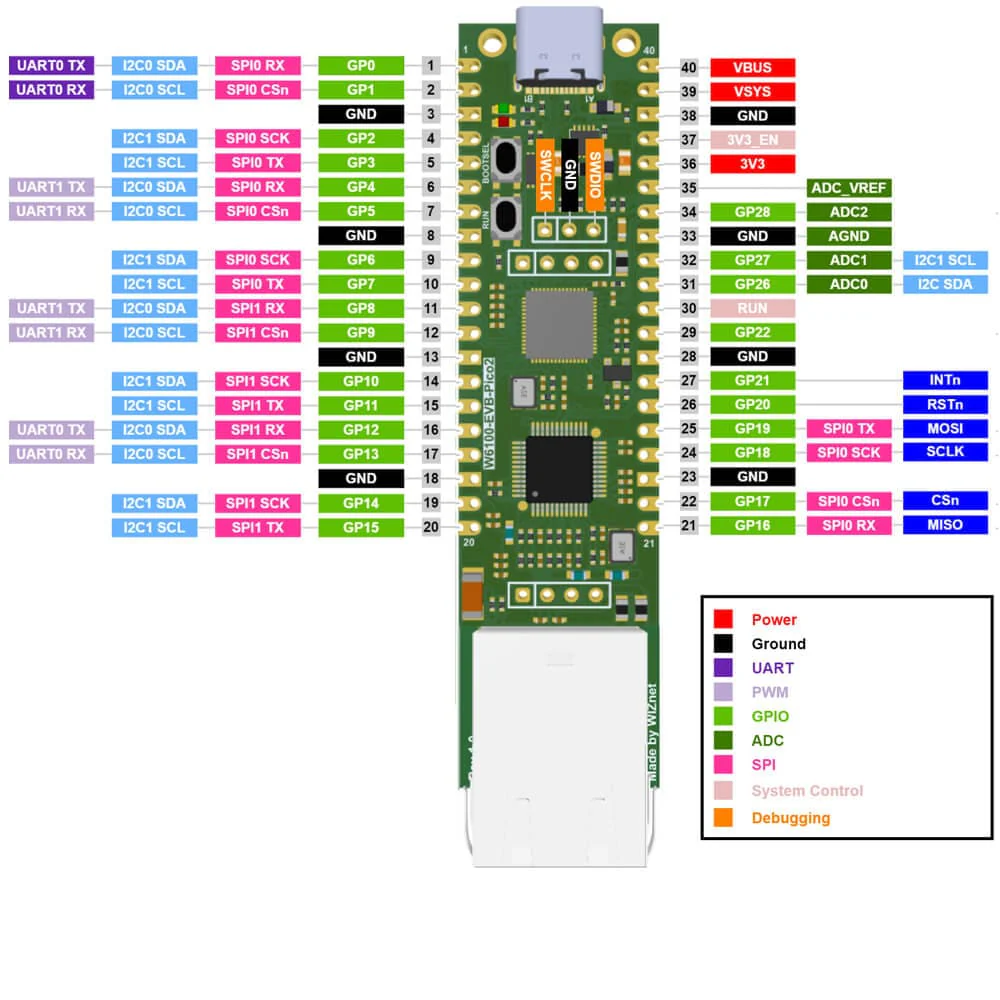
Get started with the Raspberry Pi with one of our pre-boxed kits
These kits are perfect for beginners that are just just getting exposed to the Raspberry Pi, Media enthusiasts looking to stream online content with Kodi, developers looking to exploit the many advantages of the RPI's GPIO pins and anybody looking to get some cool goodies at a great price! They contain all of the essential items that you need to get up and running in no time.
Please Note: These kits are pre-boxed and cannot be modified at all, we do however keep stock on all of the individual items so if you have a special need simply feel free to browse through the rest of our product offerings and select the items that you'd like.
What's in the box?
1 x Raspberry Pi 4 Model B 4GB
1 x Black oneninedesign case
1 x 1m micro HDMI cable
1 x 32 GB Micro SD card with Raspberry Pi OS pre-installed (SD size updated as from 25/06/2024)
1 x Raspberry Pi 4 Model B 4GB
1 x Official Pi4 black 5.1V 3A Power Supply
Want to take your kit to the next level?
Turn your RPI into a Media Centre
Grab yourself a remote control, select LibreELEC or OSMC when setting up your RPI and you'll be streaming in no time. You can even add a wireless keyboard, mouse or other similar controllers
Want a cheap eco-friendly PC
Grab a Keyboard and Mouse, select Raspbian when setting up your RPI and you'll be browsing the web, sending emails, editing spreadsheets and watching videos just like you're used to with a desktop/laptop.
We know you love retro gaming!
Check out our Arcade section, whether you just want a retro control or a mini DIY arcade cabinet we have what you're looking for.
Did somebody say Robotics?
We've got some cool beginner's items in our robotic section
Our Kits come with the latest version of Raspberry Pi OS pre-installed, While we will certainly try our best to assist with any software related questions we cannot offer any kind of official support on community driven, open source, or non-PiShop produced proprietary software.
NOOBS, Raspbian, LibreELEC and OSMC are all open-source software, please visit the developer's respective websites for more info.
A whole bunch of other really cool technical info can be found here.
Getting Started with Raspberry Pi
NVIDIA Jetson Nano Developer Kit is a small, powerful computer that lets you run multiple neural networks in parallel for applications like image classification, object detection, segmentation, and speech processing. All in an easy-to-use platform that runs in as little as 5 watts.
Jetson Nano delivers 472 GFLOPS for running modern AI algorithms fast, with a quad-core 64-bit ARM CPU, a 128-core integrated NVIDIA GPU, as well as 4GB LPDDR4 memory. It runs multiple neural networks in parallel and processes several high-resolution sensors simultaneously.
Jetson Nano is also supported by NVIDIA JetPack, which includes a board support package (BSP), CUDA, cuDNN, and TensorRT software libraries for deep learning, computer vision, GPU computing, multimedia processing, and much more. The SDK also includes the ability to natively install popular open source Machine Learning (ML) frameworks such as TensorFlow, PyTorch, Caffe / Caffe2, Keras, and MXNet, enables the developers to integrate their favorite AI model / AI framework into products fast and easily.
Upgraded 2-lanes CSI, instead of the previous 1-lane, easily play around with binocular vision
Introduction
- Core module socket
- M.2 Key E connector
- PoE pins: PoE module is not included
- 40PIN GPIO header
- Micro USB port: for 5V power input or for USB data transmission
- Gigabit Ethernet port: 10/100/1000Base-T auto-negotiation, supports PoE if external PoE module is connected
- 4x USB 3.0 port
- HDMI output port
- DisplayPort connector
- DC jack: for 5V power input
- 2x MIPI CSI camera connector
| GPU | 128-core Maxwell |
|---|---|
| CPU | Quad-core ARM A57 @ 1.43 GHz |
| Memory | 4 GB 64-bit LPDDR4 25.6 GB/s |
| Storage | 16GB eMMC |
| Video Encoder | 4K @ 30 | 4x 1080p @ 30 | 9x 720p @ 30 (H.264/H.265) |
| Video Decoder | 4K @ 60 | 2x 4K @ 30 | 8x 1080p @ 30 | 18x 720p @ 30 (H.264/H.265) |
| Camera | 2x MIPI CSI-2 DPHY lanes |
| Connectivity | Gigabit Ethernet, M.2 Key E expansion connector |
| Display | HDMI and DP |
| USB | 4x USB 3.0, USB 2.0 Micro-B |
| Extension Interfaces | GPIO, I2C, I2S, SPI, UART |
What's in the box?
1 x IMX219-77 Camera
1 x 32GB USB drive
1 x Cooling fan
1 x USB cable (~1.2m)
1 x Ethernet cable (~1.5m)
1 x 5V 4A power adapter

Resources
Wiki: JETSON-NANO-DEV-KIT
Nvidia help docs
Introduction to Jetson Developer Kits And Modules
Arduino is an open-source electronics platform based on easy-to-use hardware and software. Arduino boards are able to read inputs - light on a sensor, a finger on a button, or a Twitter message - and turn it into an output - activating a motor, turning on an LED, publishing something online.
Specifications
- Arduino compatible board
- Microcontroller ATmega328
- Operating Voltage 5V
- Input Voltage (recommended) 7-12V
- Input Voltage (limits) 6-20V
- Digital I/O Pins 14 (of which 6 provide PWM output)
- Analog Input Pins 6
- DC Current per I/O Pin 40 mA
- DC Current for 3.3V Pin 50 mA
- Flash Memory 32 KB (ATmega328) of which 0.5 KB used by bootloader
- SRAM 2 KB (ATmega328)
- EEPROM 1 KB (ATmega328)
- Clock Speed 16 MHz
- Length 68.6 mm
- Width 53.4 mm
What's in the box?
1 x UNO R3
1 x USB cable
Resources
Find more info on Arduino at https://www.arduino.cc/en/Guide
These kits are perfect for beginners that are just just getting exposed to the Raspberry Pi, Media enthusiasts looking to stream online content with Kodi, developers looking to exploit the many advantages of the RPI's GPIO pins and anybody looking to get some cool goodies at a great price! They contain all of the essential items that you need to get up and running in no time.
Please Note: These kits are pre-boxed and cannot be modified at all, we do however keep stock on all of the individual items so if you have a special need simply feel free to browse through the rest of our product offerings and select the items that you'd like.
What's in the box?
1 x Official 5V 2.5A Power Supply in White
1 x 1m official HDMI cable
1 x 32 GB Micro SD card with Raspberry Pi OS pre-loaded
1 x Official Pi3 Red/White Case
Want to take your kit to the next level?
Turn your RPI into a Media Centre
Grab yourself a remote control, install LibreELEC or OSMC when setting up your RPI and you'll be streaming in no time. You can even add a wireless keyboard, mouse or other similar controllers
Want a cheap eco-friendly PC
Grab a Keyboard and Mouse, select Raspbian when setting up your RPI and you'll be browsing the web, sending emails, editing spreadsheets and watching videos just like you're used to with a desktop/laptop.
We know you love retro gaming!
RetroPie allows you to turn your Raspberry Pi into a retro-gaming machine Check out our Arcade section, whether you just want a retro control or a mini DIY arcade cabinet we have what you're looking for.
Did somebody say Robotics?
We've got some cool beginner's items in our robotic section
Our Kits come with the latest version of Raspberry Pi OS pre-installed, While we will certainly try our best to assist with any software related questions we cannot offer any kind of official support on community driven, open source, or non-PiShop produced proprietary software.
NOOBS, Raspbian, RetroPie, LibreELEC and OSMC are all examples of open-source software, please visit the developer's respective websites for more info.
A whole bunch of other really cool technical info can be found here.
Where do I start?.........Getting Started with Raspberry Pi
Features
- Safe and Visible
- FDA Class 1 Safety Certification
- 360° Visual Design, Combines Aesthetics with Versatility.
- Pilot Technology, Visual Assistance for Precise Positioning
- Full-field Protection, Unleash Unlimited Creative Space.
- Drawer Design, Good Helper for Desktop Organization
- Fence Type Protection Strip, Heat and Smoke Dissipation
- High-efficiency Batch, Profit in Your Pocket

Resources
Features
- Safe and Visible
- FDA Class 1 Safety Certification
- 360° Visual Design, Combines Aesthetics with Versatility.
- Pilot Technology, Visual Assistance for Precise Positioning
- Full-field Protection, Unleash Unlimited Creative Space.
- Drawer Design, Good Helper for Desktop Organization
- Fence Type Protection Strip, Heat and Smoke Dissipation
- High-efficiency Batch, Profit in Your Pocket

Resources
Features
- Intelligent Three-level adjustable beam
- Cutting Power Up to 60w
- 3 Lasers in one Machine
- Super-higher Working Efficiency
- Fully Enclosed Design
- Built-in Camera for Auto-positioning
Specifications
- Product Name: Creality Falcon2 Pro 60W
- Machine Power (MAX): 360W
- Optical Power: 60W+1.6W
- Product Size: 664*570*328.4mm
- Equipment Weight: 19.51kg
- Input Voltage: 100-240V~ 50-60Hz
- Output Voltage: DC 24.0V 15.0A
- Operating Temperature: 5℃-35℃
- Engraving Area: 400mm*400mm
- Laser Source: Diode Laser
- Laser Spot: 0.08*0.15mm
- Laser Wavelength: 455±5nm
- Laser Class: Class 1(FDA)
- Laser Engraving Software: LightBurn、LaserGRBL
- Operating System: Windows/MacOS
- Supported File Formats: Jpeg, jpg, png, bmp, svg, dxf, etc.
- Supported Materials: Cardboard, wood, bamboo, rubber, leather, fabric, acrylic, plastic, etc.
- Certifications: EC60825、FDA、CE、ROHS、FCC、UKCA、UL Report、PSE
- Gross Weight: 25.74KG
- Package Size: 770mm x 645mm x 285mm
What's in the box?
1 x Creality Falcon2 60W PRO Laser
Key Features of the OKdo Nano C100 Developer Kit
- Jetson Nano Module
- 128-core NVIDIA Maxwell GPU
- Quad-core ARM A57 CPU
- 4 GB 64-bit LPDDR4
- 10/100/1000BASE-T Ethernet
- Power Options
- Micro-USB 5V 2A
- DC power adapter 5V 4A
- Extensive I/Os
- USB 3.0 Type A
- USB 2.0 Micro-B
- HDMI/DisplayPort
- M.2 Key E
- Gigabit Ethernet
- GPIOs,I2C, I2S, SPI, UART
- 2x M IPI-CSI camera connector
- Micro SD card
- Fan connector
Specifications
- GPU 128-core Maxwell
- CPU Quad-core ARM A57 @ 1.43 GHz
- Memory 4 GB 64-bit LPDDR4 25.6 GB/s
- Storage 16GB eMMC and microSD (not included)
- Video Encoder 4K @ 30 | 4x 1080p @ 30 | 9x 720p @ 30 (H.264/H.265)
- Video Decoder 4K @ 60 | 2x 4K @ 30 | 8x 1080p @ 30 | 18x 720p @ 30|
- (H.264/H.265)
- Camera 2x MIPI CSI-2 DPHY lanes
- Connectivity Gigabit Ethernet, M.2 Key E
- Display HDMI 2.0 and eDP 1.4
- USB 4x USB 3.0, USB 2.0 Micro-B
- Others GPIO, IC2, I 2 S, SPI, UART
- Dimensions 100 mm x 80 mm x 29 m
What's in the box?
1 x NVIDIA Jetson Nano module
1 x Radxa Nano C100 carrier board
1 x Quick Start Guide and Support Guide
Resources
Wiki: JETSON-NANO-DEV-KIT
Nvidia help docs
Introduction to Jetson Developer Kits And Modules
Please note: You will have to buy a different DSI cable to use with Raspberry Pi 5.
This seven-inch, 800 x 480 touchscreen display lets you create interactive Raspberry Pi projects like tablets, entertainment systems, and information dashboards. It’s powered from your Raspberry Pi; no separate power supply is required.
Raspberry Pi OS provides touchscreen drivers with support for ten-finger touch and an on-screen keyboard, giving you full functionality without the need to connect a keyboard or mouse.
The display connects to Raspberry Pi via an adapter board that handles power and signal conversion. Only two connections to your Raspberry Pi are required: power from the GPIO port, and a ribbon cable that connects to the DSI port on all Raspberry Pi computers except for Raspberry Pi 400 and the Raspberry Pi Zero line.
Specifications
- Display size (diagonal): 7 inches
- Display format: 800 (RGB) × 480 pixels
- Active area: 154.08mm × 85.92mm
- Touch panel: True multi-touch capacitive touch panel with up to 10 points of absolution
What's in the box?
1 x 7” Touchscreen Display with Adapter Board
1 x DSI Ribbon cable
4 x screws (used to mount the Raspberry Pi board to the back of the display
2 x jumper wires (used to connect the power from the Adapter Board and the GPIO pins on the Pi so the power is shared across both units)
Please Note. The Raspberry Pi Board and accessories are not included with this product.
Resources
2 pin through hole rectifier diodes used for electronic projects, hobbies and repairs. Used in radios, power supplies and other devices.
- Wattage: 1W
- Diode/rectifier type: DO-41
- RoHS: Yes
- Standard Recovery Power Rectifier
- Repetitive Reverse Voltage Max, Vrrm: 50V
- Forward Current Avg Rectified, IF(AV): 1A
- Forward Surge Current Max, Ifsm: 30A
- Forward Voltage Max, VF: 1.1V
- Current Rating: 1A
- Mode: IN5822, IN5408, IN5399, FR207, FR107, IN5819, IN4007, IN4148
Resources
Intoduction
Basics, Types, Characteristics, Applications & Packages
If you love to power your projects with convenient 5V USB, then this DC-DC Step-Down Buck Module with Dual USB 5V 3A Output is an ideal choice!
Dual USB Output Buck Power Supply Adapter For Car Auto Cellphone MP3 and much more!
Specifications
- Model:usb1002
- Name: Power Module
- Features: Buck Charge
- Product size: 33mm x 33mm x 8mm
- Input voltage range: 6-24V
- Output voltage: 5.2V (the output terminal is 5.3-5.4V, the load side is 5.1-5.2V)
- Output Current: 3A (without heat sink, the stability of the output current is 2A)
Important Notes
- The input voltage can not exceed 24V, otherwise it will cause damage to the device!
- The input positive and negative can not be reversed, otherwise it will cause damage to the device!
- You will only be able to make use of the 3A current rating at higher input voltages!
What's in the box?
1 x Dual USB Power Module
This is a new design ABS case to protect your Raspberry Pi 4 Model B computer, it is only compatible with your Raspberry Pi 4 Model B, does not support other versions. Also supports a dc 5v cooling fan.
Features
- ABS material.
- Easy to install.
- All ports and slots of the case match with Raspberry Pi 4 Computer Model B perfectly.
- Supports a DC 5v extractor cooling fan.
What's in the box?
1 x ABS Case for Raspberry Pi 4 Model B
1 x Cooling Fan 30mm x 30mm x 7mm
4 x Heat Sinks(new add on to this case)
Resources














